マッハツェンダー型干渉計
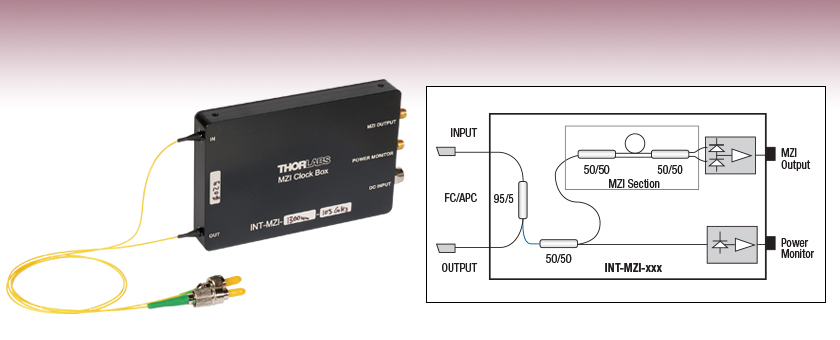
- OCT-Proven Clock for Swept Source Systems
- Compact Design that Allows Subassembly Integration
- Several Wavelengths Available
INT-MZI-1300

Please Wait
| Item # | Wavelength Rangea | Detector Type | Free Spectral Range | Insertion Lossa |
|---|---|---|---|---|
| INT-MZI-850 | 780 - 925 nm | Si/PIN | 103.3 GHz ± 5% | <1.5 dB (Typ.), 3 dB (Max) |
| INT-MZI-1300 | 1225 - 1375 nm | InGaAs/PIN | <0.7 dB (Typ.), 1 dB (Max) |
特長
- 2つの中心波長モデル:中心波長850 nmと1300 nm
- 掃引光源出力周波数モニタに使用可能
- 差分ディテクタ出力
- 低い挿入損失:<3 dB
- 平坦な波長特性
- パワーモニタとkクロック信号用ディテクタ内蔵
- 干渉計用電源が付属
当社のマッハツェンダ干渉計クロックボックスサブアセンブリMZIシリーズは、中心波長が850 nmあるいは1300 nmでの波長掃引光コヒーレントトモグラフィ(OCT)システムで使用されるように設計されています。内部で使用されているファイバーカプラは平坦な波長特性と低い偏光依存性を実現するように最適化されています。そのため、出力信号は入力の偏光の変化に依存しません。このクロックボックスには、掃引レーザ光源の出力と、波長をモニタするためのパワーモニタ信号とkクロック信号の2つのディテクタが内蔵されています。どちらの出力も200 MHzの帯域幅で、kクロックはコモンモード雑音最大限に除去するため差分検出スキームを採用しています。
また、このクロックはもともとOCT用に設計されていますが、他の同期化用途にもお使いいただけます。
クロックに関する詳細は、「動作原理」のタブをご参照ください。
注: カスタム仕様のスペクトル範囲や波長にも対応いたします。詳細は、当社までお問い合わせください。
| Item # | INT-MZI-850 | INT-MZI-1300 |
|---|---|---|
| Optical Specifications | ||
| Interferometer Wavelength Range | 780 - 925 nm | 1225 - 1375 nm |
| Free Spectral Range | 103.3 GHz ±5% | 103.3 GHz ±5% |
| Fiber Type | Nufern 780-HP™ | Corning SMF28™ |
| Input/Output Connection | FC/APC Pigtail, 50 cm Long | |
| Insertion Lossa | < 1.5 dB (Typ.), 3 dB (Max) | < 0.7 dB (Typ.), 1 dB (Max) |
| Electrical Specifications | ||
| Detector Material/Type | Si/PIN | InGaAs/PIN |
| Detector Wavelength Range | 320 - 1000 nm | 800 - 1700 nm |
| Typical Responsivity (Max) | 0.53 A/W | 1.0 A/W |
| MZI Output Bandwidth (3dB) | DC - 200 MHz | |
| Conversion Gain Power Monitorb | 30 V/W (±25%) | 60 V/W (±25%) |
| Conversion Gain MZI Outputb | ±30 V/W (±25%) | ±60 V/W (±25%) |
| Saturation Power | 100 mW @ 850 nm | 50 mW @ 1300 nm |
| Maximum Input Power | 250 mW (Photodiode Damage Threshold) | |
| Electrical Outputs | SMA | |
| Impedance | 50 Ω | |
| DC Offset | < ±5 mV | |
| Power Supply | ±12 V @ 250 mA (100/120/230 VAC, 50 - 60 Hz, Switchable) | |
| General Specifications | ||
| Dimensions | 120 mm x 80 mm x 16 mm | |
動作原理
高速波長掃引レーザ光源では、OCTイメージング用途に必要な高速の周波数掃引を実現するために、しばしば正弦波的に変化するチューニング素子を使用します。最終データが周波数空間に等間隔に配置されるためには、正確かつ信頼できるOCT信号の較正が必要です。当社の波長掃引レーザ光源には、この目的だけに使用できる差分ディテクタ出力を備えたマッハツェンダ干渉計(MZI)が内蔵されており、MZIの干渉縞信号のゼロ交差が光周波数で等間隔(k空間)に配置されているので、周波数クロックとして使用できます。このクロックはOCT用途向けに開発されましたが、他の同期化用途にも使用可能です。
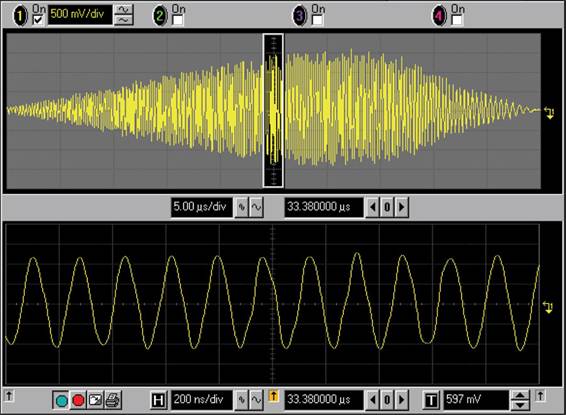
図 1: MZIクロック信号
図2は、システムの概略図です。内部のファイバーネットワークを使用して、5%の入力光を分離してパワーモニタとkクロック信号を生成します。 残りの光は出力ピグテールに送信されます。特注のカプラが出力光とパワーモニタ信号の両方で平坦な波長特性となるように設計されています(図3と4参照)。MZIの信号はどちらも超低雑音増幅器差分フォトディテクタで検出されます。
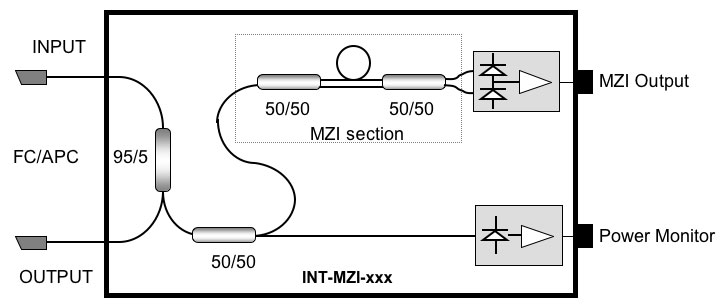
図2: MZIシリーズクロックボックスの構成
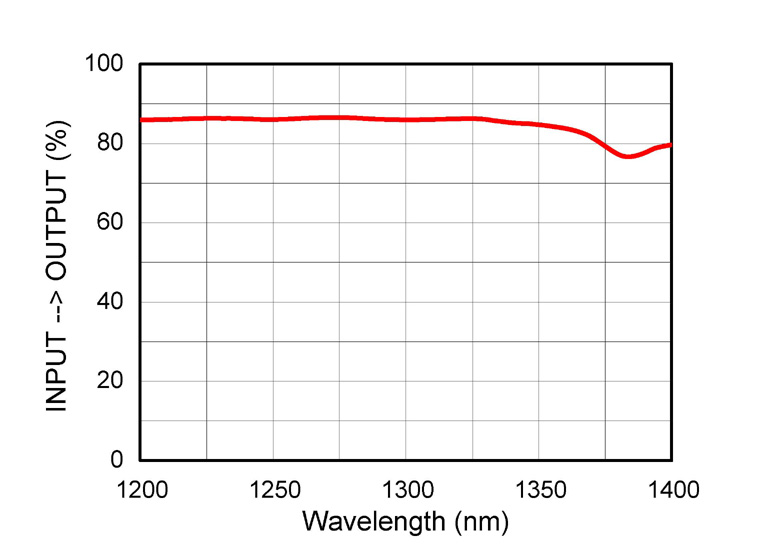
図3: INT-MZI-1300の入力に対する出力光の結合効率
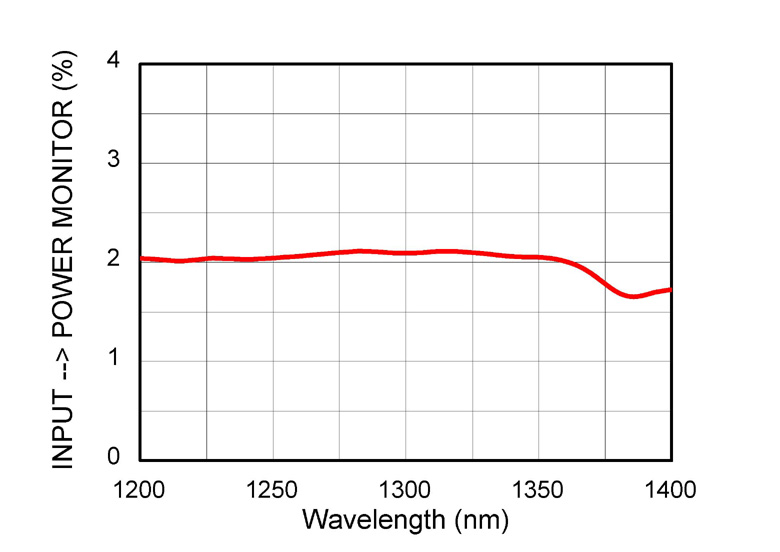
図4: INT-MZI-1300の入力に対するパワーモニタ分岐の結合効率
Power Monitor Ouput
SMA Female

0 - 1.8 V (50 Ω) or 0 - 3.6 V (High Z)
Mach-Zehnder Interferometer Output
SMA Female

0 - 1.8 V (50 Ω) or 0 - 3.6 V (High Z)
| Posted Comments: | |
Nico Neumann
(posted 2022-11-02 15:42:35.777) Can you specify the robustness of the FSR to temperature changes? How temperature stable are your MZI? dpossin
(posted 2022-11-04 12:42:10.0) Dear Nico,
Thank you for your feedback. As we do not specify the MZI outside of the temperature range of 23°C +/- 5°C we currently can´t make a statement on the actual robustness. Since the fibernetwork inside the case will increase or decrease in length as the temperature changes potentially the frequency mismatch will increase too. I´ll reach out to you in order to further discuss this issue. ming-wei lai
(posted 2021-07-25 20:00:40.143) I set up a SSOCT system. Our DAQ is NI usb-6356, sample rate is 1MSPS(mega sample per second) , Laser is TLS-550 center wavelength is 1310nm.
I wanna know your product's limit. Can I using this in our system? MKiess
(posted 2021-08-05 03:43:39.0) Dear Ling-Wei Lai, thank you for your inquiry. I have contacted you directly to discuss the exact application and requirements for implementing the interferometer in your system. ckdgus6819
(posted 2017-03-28 12:45:01.22) Do you have 1500nm MZI clock box?? swick
(posted 2017-03-30 03:21:23.0) This is a response from Sebastian at Thorlabs. Thank you for the inquiry.
We can offer customized version of our Mach-Zehnder Type Interferometers for different wavelengths. I will contact you directly to check your requirements in detail. amahend
(posted 2016-05-25 10:56:25.543) Do you have similar product mach zehnder interferometer but the MZI output using optical connector (or remove the PD) so this can act as delay line interferometer? besembeson
(posted 2016-05-25 05:22:21.0) Response from Bweh at Thorlabs USA: We don't have such a fiber based interferometer at this time. We could look into a custom solution according to your requirements. I will contact you. jlow
(posted 2012-11-01 13:17:00.0) Response from Jeremy at Thorlabs: The MZI clock isn't designed for external clocking the DAQ card. Instead the MZI clock signals are acquired by the DAQ card simultaneously with the OCT signals. Then software is used to process the MZI clock signals and interpolate the zero-crossing to build the time-to-frequency conversion to perform a linear FFT. The number of raw clock points that comes out of the MZI is about 400-450 points. We recommend interpolating approximately 4x those points to perform a 2048 point FFT. avle
(posted 2012-10-24 02:06:41.657) How many points per scan does the mzi clock generate when using the SL1325-P16 laser for external clocking? Tyler
(posted 2008-03-18 10:51:24.0) Response from Tyler at Thorlabs to r93941013: Thank you for your interest in our product. The output of the MZI Clock Box can be used to trigger the data acquisition board. The output signal consists of a sinusoidal signal with zero crossings that are equally spaced in frequency. r93941013
(posted 2008-03-16 21:49:52.0) Hello,
I am interested in this product. About the clock box, the MZI output signal could be directly used as the clock signal of data acquistion board? If not, the advanced calculation inplementation is required. Therefore, more input channel is essential fro frequency calibration. Waiting for more deailed response, thx. By the way, our primary application is swept source OCT application.
Hsiang Chieh Lee
National Taiwan University, Taiwan |
 Products Home
Products Home







 マッハツェンダ干渉計
マッハツェンダ干渉計